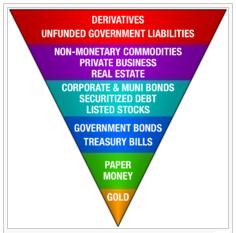From Exter's Pyramid To World of Finance
To understand why there's so much manipulation taking place in the "world of finance," it would help to know just what IS the "world of finance." Barclays used to have a corporate slogan: "Quietly conquering the world of finance." One illustration that some folks use to explain this financial world is Exter's Pyramid.
John Exter was a central banker, a member of the Pilgrim society, among other things. Personally, I don't trust any organization that would have Henry Kissinger as a member. But that's besides the point, and anyway, to them I'm irrelevant. Wikipedia has more on John Exter (here)
It should be obvious that Exter's inverted pyramid cannot stand alone in nature. No pyramid stands on it's point. Even if he pretends to try to make a point.
One side of Exter's pyramid is simply a triangle, like a slice removed from a pizza. Rotate the inverted pyramid in your mind so that a complete circle is formed. This is the same view as if you had sliced our world in half.
But that is not the "world of finance, either. So take one more step. In your mind, rotate the "pizza" into a sphere. Now you have the "world of finance" with gold (and silver) at its center. Think of the "world of finance" as similar to the physical world in which we live, with solid earth as its core, and everything else above the ground as its atmosphere.
And why not, as promises can be as flighty and weighless as gases. Everything above the golden core are simply "promises." And no matter how you travel through the layers, promises are exchanged for other promises. Only when promises are exchanged for gold can you be on "solid" ground.
With Exter's inverted pyramid rotated, you can "see" the "world of finance," with a golden core and layers of finance above it, just like earth's atmosphere. In fact, I think it corresponds quite well. That gives new meaning to these phrases; "high-flying securities," "blue-sky ventures," "launching new securities," I'm sure you can name some examples yourself.
My point is that everything above gold (and silver) are nothing more than promises. The only solid point of reference is in the core. Everything else can be created from almost nothing, and it can disappear into the void almost effortlessly. Which is exactly why those who profit from manipulating promises hate gold. For their surivival, they need you to trade your physical labor and objects for paper promises. It's they only way they can pilfer your savings without physical confrontation. ----------------------------------------------- Sometimes, the only way to explain that gold/silver is not in a bubble is by examining an actual real-time bubble, which happens to be Apple Inc. at this moment. Why do I say that?
While investigating the wholesale dumping of gold/silver mining shares by Blackrock in a previous commentary , it seemed logical to see just where they WERE putting the biggest share of their funds. Turns out it was Apple Inc.!
Looking a little deeper, not only was Apple stock Blackrock's #1
position, but 414 other institutions had made it their #1 investment, too.
That! I would call a "bubble."
You will find an alphabetical list of these institutions, along with the total value of their investments, here (PDF).
You will find the same list, sorted by the total value of their investment,
here (PDF).
In this list, I've also inserted the portfolio position
and the ticker symbol of the largest precious metal investments of
those companies with over a $1 billion invested in Apple.
Perhaps it's now obvious that precious metals are far from being in a bubble, at least a bubble as compared to Apple Inc.
What's now even more interesting is that by the time these SEC filings were available to the public, Apple's stock price had started to fall. As of this writing, the stock price had fallen 23.58% from 9/30/2012 to 12/14/2012. This means Blackrock, as a group, could have losses up to $7.75 billion, depending on when they unloaded their shares since the SEC filing. As a group of #1 position holders, the loss could be as high as $74.66 billion. Wow!
Perhaps holding onto physical gold and silver for long-term investment
isn't such a bad idea,
because
Sometimes
The Dragon Wins
© 2012 by Edward Ulysses Cate
Help Support This Site
Commentary Index
Home
